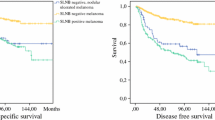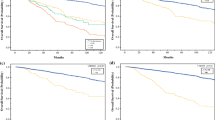Abstract
Purpose
To assess postbiopsy pigmentation (PBP) as a prognostic feature in patients with cutaneous head and neck (H&N) melanoma.
Methods
Retrospective review of patients undergoing sentinel lymph node biopsy (SLNB) for H&N melanoma (1998–2018). PBP was defined as visible remaining pigment at the scar or biopsy site that was documented on physical exam by both a medical oncologist and a surgeon at initial consultation. Variables associated with disease-free survival (DFS) and overall survival (OS) were analyzed using multivariable Cox proportional hazards models.
Results
Among 300 patients, 34.3% (n = 103) had PBP and 44.7% (n = 134) had microscopic residual disease on final pathology after wide local excision. Prognostic factors associated with DFS included advanced age, tumor depth, ulceration, PBP, and positive SLNB (p < 0.05). Patients with PBP fared worse than their counterparts without PBP in 5-year DFS [44.1% (31.1–56.3%) vs. 73.0% (64.1–80.0%); p < 0.001] and 5-year OS [65.0% (50.0–76.6%) vs. 83.6% (75.7–89.2%); p = 0.005]. After multivariable adjustment, PBP remained associated with shorter DFS [hazard ratio (HR) 1.72, 95% confidence interval (CI) 1.01–2.93; p = 0.047], but was not prognostic of OS.
Conclusions
In patients with H&N melanoma, PBP is associated with significantly shorter DFS. Patients with PBP may warrant greater consideration for SLNB and closer postoperative surveillance.

Similar content being viewed by others
References
Siegel RL, Miller KD, Jemal A. Cancer statistics, 2017. CA Cancer J Clin. 2017;67(1):7–30.
Golger A, Young DS, Ghazarian D, Neligan PC. Epidemiological features and prognostic factors of cutaneous head and neck melanoma: a population-based study. Arch Otolaryngol Head Neck Surg. 2007;133(5):442–7.
Hoersch B, Leiter U, Garbe C. Is head and neck melanoma a distinct entity? A clinical registry-based comparative study in 5702 patients with melanoma. Br J Dermatol. 2006;155(4):771–7.
Lachiewicz AM, Berwick M, Wiggins CL, Thomas NE. Survival differences between patients with scalp or neck melanoma and those with melanoma of other sites in the Surveillance, Epidemiology, and End Results (SEER) program. Arch Dermatol. 2008;144(4):515–21.
Balch CM, Soong SJ, Gershenwald JE, et al. Prognostic factors analysis of 17,600 melanoma patients: validation of the American Joint Committee on cancer melanoma staging system. J Clin Oncol. 2001;19(16):3622–34.
Thompson JF, Soong S-J, Balch CM, et al. Prognostic significance of mitotic rate in localized primary cutaneous melanoma: an analysis of patients in the multi-institutional American Joint Committee on Cancer melanoma staging database. J Clin Oncol. 2011;29(16):2199–2205.
Xie C, Pan Y, McLean C, Mar V, Wolfe R, Kelly JW. Scalp melanoma: distinctive high risk clinical and histological features. Australas J Dermatol. 2017;58(3):181–8.
Xie C, Pan Y, McLean C, Mar V, Wolfe R, Kelly J. Impact of scalp location on survival in head and neck melanoma: a retrospective cohort study. J Am Acad Dermatol. 2017;76(3):494–498.e2.
Lin D, Franc BL, Kashani-Sabet M, Singer MI. Lymphatic drainage patterns of head and neck cutaneous melanoma observed on lymphoscintigraphy and sentinel lymph node biopsy. Head Neck. 2006;28(3):249–55.
Fincher TR, O’Brien JC, McCarty TM, et al. Patterns of drainage and recurrence following sentinel lymph node biopsy for cutaneous melanoma of the head and neck. Arch Otolaryngol Head Neck Surg. 2004;130(7):844–8.
Stewart CL, Gleisner A, Kwak J, et al. Implications of sentinel lymph node drainage to multiple basins in head and neck melanoma. Ann Surg Oncol. 2017;24(5):1386–91.
Gillgren P, Månsson-Brahme E, Frisell J, Johansson H, Larsson O, Ringborg U. A prospective population-based study of cutaneous malignant melanoma of the head and neck. Laryngoscope. 2000;110(9):1498–504.
Stokes WA, Lentsch EJ. Age is an independent poor prognostic factor in cutaneous head and neck melanoma. Laryngoscope. 2014;124(2):462–5.
Arce PM, Camilon PR, Stokes WA, Nguyen SA, Lentsch EJ. Is sex an independent prognostic factor in cutaneous head and neck melanoma? Laryngoscope. 2014;124(6):1363–67.
Tseng WH, Martinez SR. Tumor location predicts survival in cutaneous head and neck melanoma. J Surg Res. 2011;167(2):192–8.
Leong SPL, Accortt NA, Essner R, et al. Impact of sentinel node status and other risk factors on the clinical outcome of head and neck melanoma patients. Arch Otolaryngol Head Neck Surg. 2006;132(4):370–3.
Mills JK, White I, Diggs B, Fortino J, Vetto JT. Effect of biopsy type on outcomes in the treatment of primary cutaneous melanoma. Am J Surg. 2013;205(5):585–90 (discussion 590).
Molenkamp BG, Sluijter BJR, Oosterhof B, Meijer S, van Leeuwen PAM. Non-radical diagnostic biopsies do not negatively influence melanoma patient survival. Ann Surg Oncol. 2007;14(4):1424–30.
Egnatios GL, Dueck AC, Macdonald JB, et al. The impact of biopsy technique on upstaging, residual disease, and outcome in cutaneous melanoma. Am J Surg. 2011;202(6):771–7 (discussion 777–778).
Hocevar M, Dragonja Z, Pilko G, Gazic B, Zgajnar J. Residual melanoma after an excisional biopsy is an independent prognostic factor for local recurrence and overall survival. Eur J Surg Oncol. 2014;40(10):1271–75.
Coit DG, Thompson JA, Algazi A, et al. Melanoma, Version 2.2016, NCCN clinical practice guidelines in oncology. J Natl Compr Cancer Netw. 2016;14(4):450–73.
Koshenkov VP, Shulkin D, Bustami R, Chevinsky AH, Whitman ED. Role of sentinel lymphadenectomy in thin cutaneous melanomas with positive deep margins on initial biopsy. J Surg Oncol. 2012;106(4):363–8.
Author information
Authors and Affiliations
Corresponding author
Additional information
Publisher's Note
Springer Nature remains neutral with regard to jurisdictional claims in published maps and institutional affiliations.
Rights and permissions
About this article
Cite this article
King, B.B.T., Chapman, B.C., Gleisner, A. et al. Postbiopsy Pigmentation is Prognostic in Head and Neck Melanoma. Ann Surg Oncol 26, 1046–1054 (2019). https://doi.org/10.1245/s10434-019-07185-2
Received:
Published:
Issue Date:
DOI: https://doi.org/10.1245/s10434-019-07185-2




